While I was staying in Banja Koviljača, I went to Loznica (Лозница) on a couple of occasions. This was neither difficult nor complicated, since these two towns are less than 7 km one from the other and their position can also be easily seen in the following map that shows all the places and monuments of culture I visited during this trip, i.e., during my week-long stay at the spa.
One of the main roads between Banja Koviljača and Loznica passes by the former factory HI Viskoza Loznica which back in the day was the backbone of the economic life in this area. The factory was founded in 1957 and it manufactured artificial silk and viscose products, but towards the end of the 20th century it practically decayed completely during the economic crisis that was omnipresent in Serbia in those days. At the beginning of the 21st century, everything that had any value was thoroughly looted from the factory and nowadays its “skeleton” stands here idly near the road. Once I heard a story that the site was offered for shooting films (probably those with post-apocalyptic scenes), but I don’t know if that was true and what came out of that.
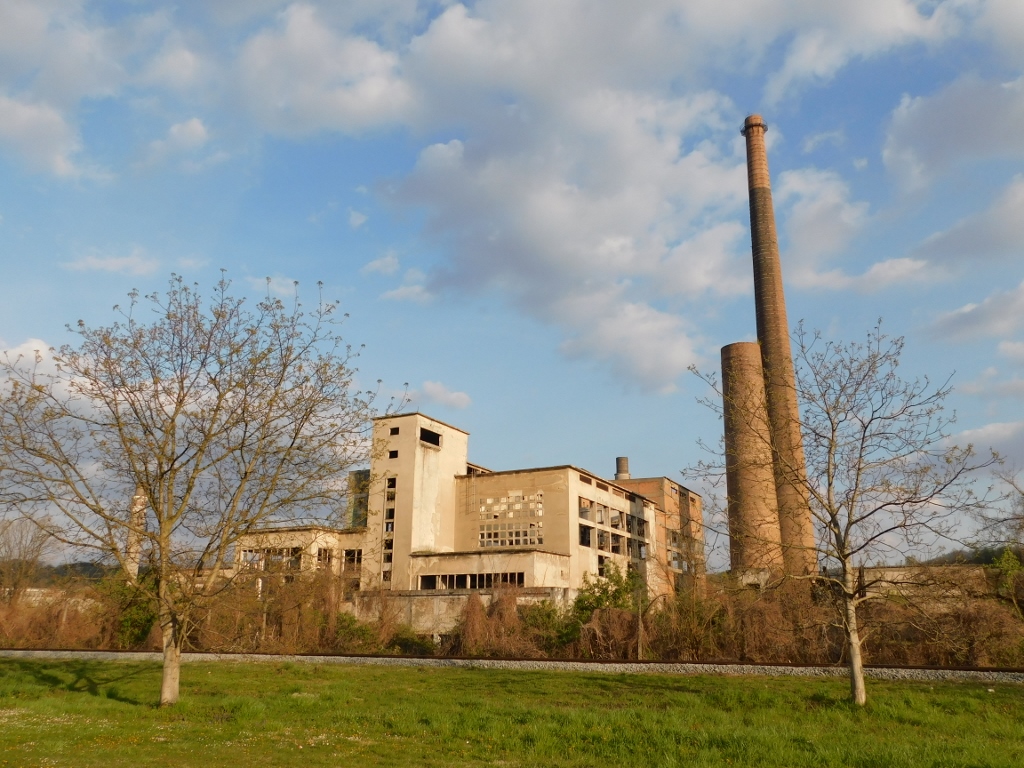 Remains of a once upon a time successful factory for the production of viscose
Remains of a once upon a time successful factory for the production of viscose
As far as Loznica is concerned, this is a town with some 20,000 inhabitants located in west Serbia and there are several monuments of culture in it that I planned to visit. Since on Sundays there are no official spa treatments at the Special Hospital for Rehabilitation “Banja Koviljača” where I had booked my stay and therapies, my plan was to use precisely this Sunday to do the sightseeing around Loznica. As it turned out, the main museum in the town does not work on Sunday, so I thought I would visit the museum on a working day after my therapies.
First I drove to a hillock in the very centre of the town that I had taken a good photo of a couple of days earlier, so here is this photo.
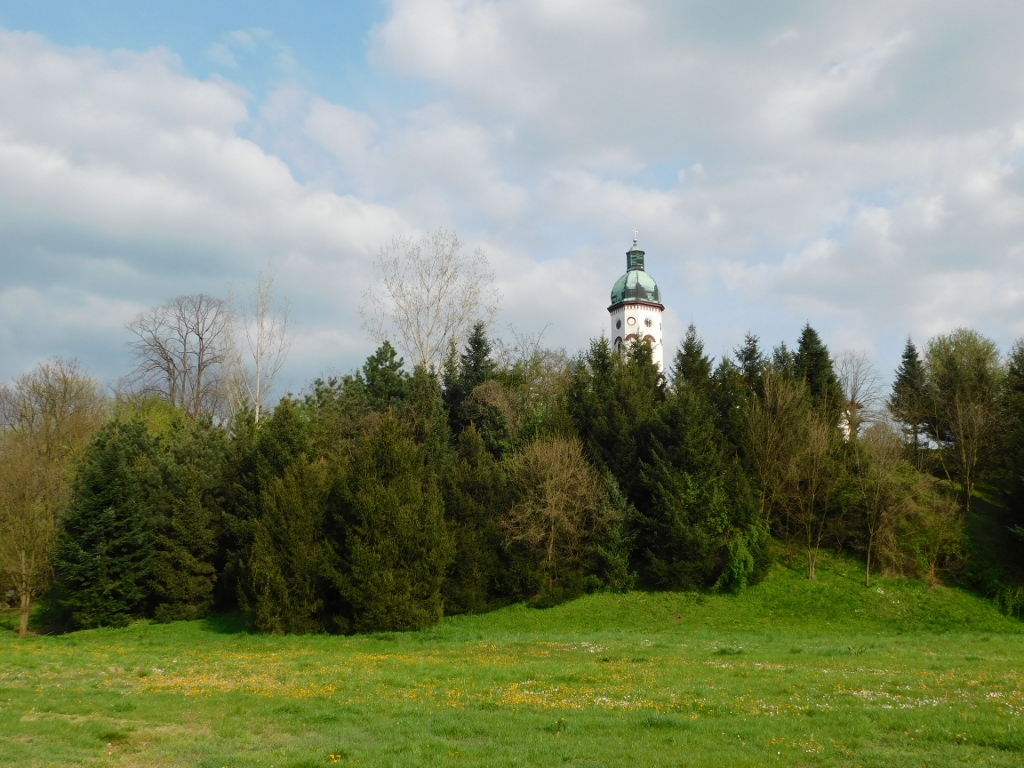 Hillock with a church in the centre of Loznica
Hillock with a church in the centre of Loznica
On the top of the hillock there is the Church of the Intercession of the Theotokos that was built in 1873 on the spot where there used to be an earlier church. As it was Sunday morning, there was a service at the church at the time of my visit and the church was full of the people, so I did not even enter, less tried to take photos of the interior.
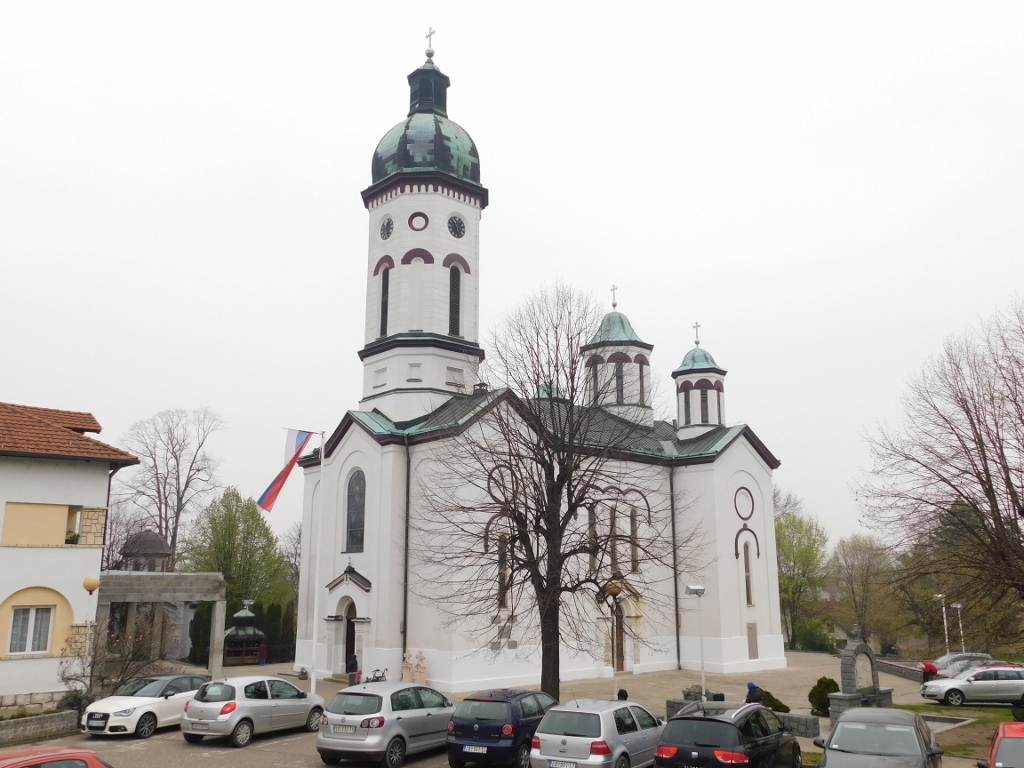 Church of the Intercession of the Theotokos
Church of the Intercession of the Theotokos
On the other hand, the main reason why I wanted to come here is that there are apparently remains of Loznički grad here which constitute a monument of culture. These are in fact remains of a fortification from the First Serbian Uprising, but I did not manage to discern any remains of ramparts and ditches. It seemed to me that this entire area had either been made contemporary by building a parking lot and various buildings or it was simply covered in vegetation. Admittedly, in one place you can see wooden objects that suggest a cannon and ramparts.
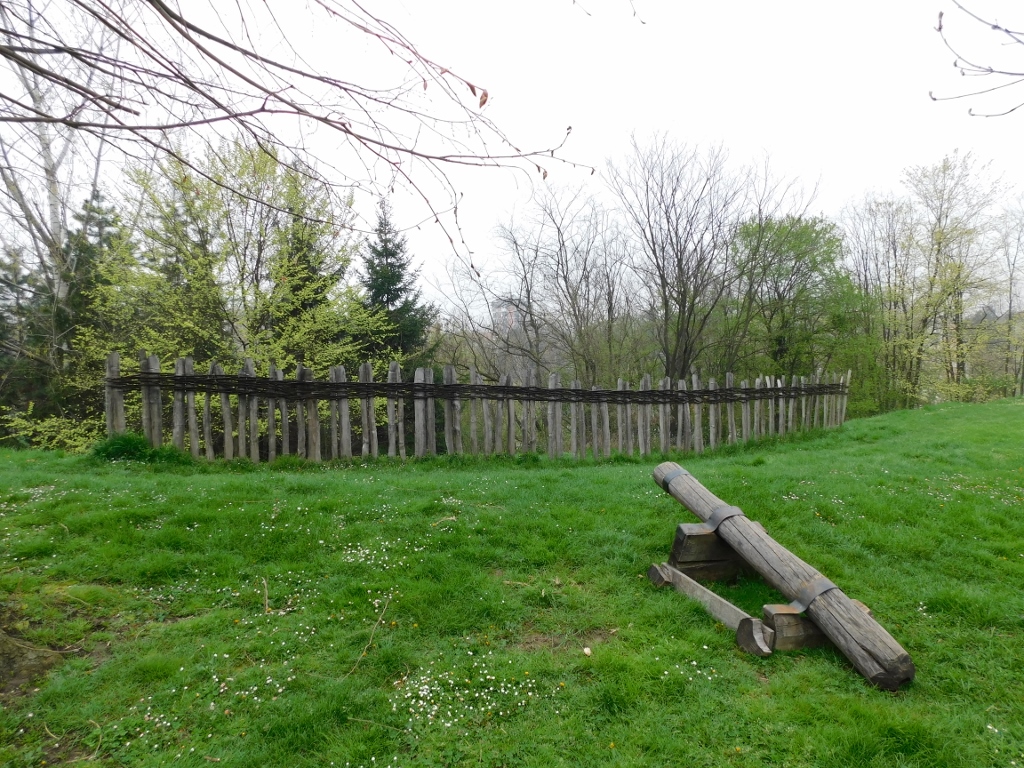 Reminder of Loznički grad and the First Serbian Uprising
Reminder of Loznički grad and the First Serbian Uprising
Namely Loznica sconce was built here in 1807 and it played an important role in the battles for the liberation of Serbia from the Ottoman rule during the First Serbian Uprising (1804-1813). At the beginning of October 1810 (the middle of October according to the Gregorian calendar), the Battle for Loznica took place here. Led by Voivode Antonije Anta Bogićević (1758-1813), the Serbian rebels prevailed over the multiply stronger and more numerous Ottoman army. This victory is one of the most important Serbian victories in the First Serbian Uprising.
The famous Serbian voivode (or vojvoda – military commander) died in Loznica in 1813 and was buried within the sconce, but after recapturing the town later that year the Ottomans dug out his body, cut off his head and took it to Zvornik, while throwing the rest of the body into a pond within the sconce. Local people did take the body out of the pond and reburied it in the original grave. Nowadays, the grave is located within a chapel built by the church.
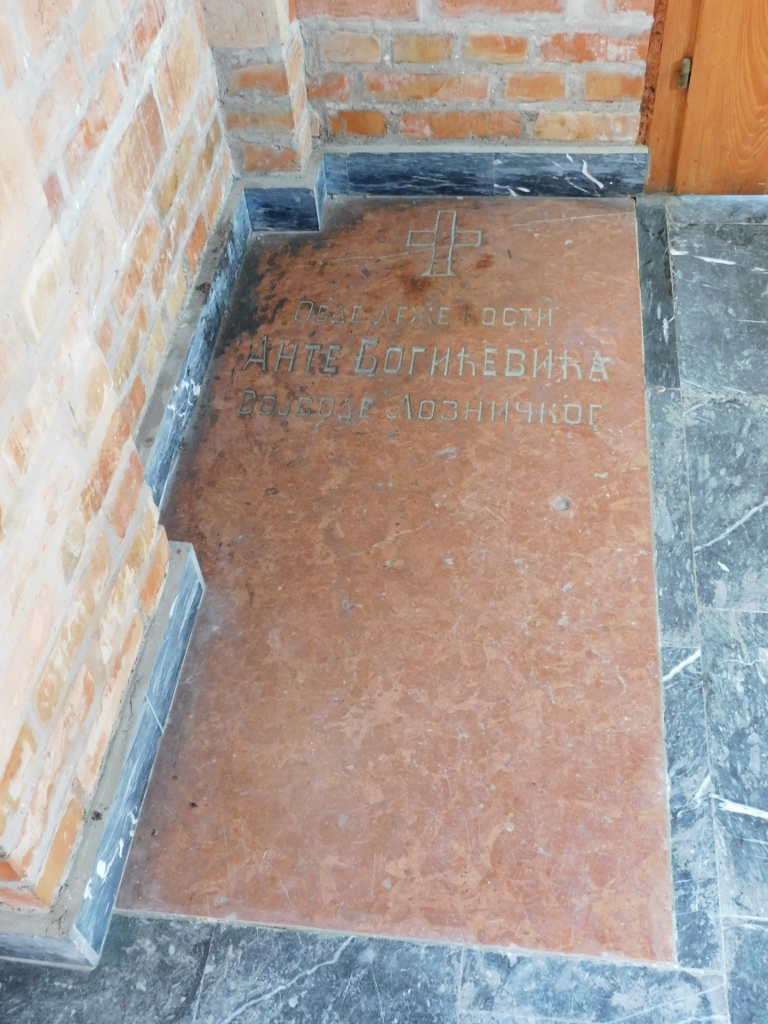 Grave of Serbian Voivode Anta Bogićević
Grave of Serbian Voivode Anta Bogićević
Within the complex that is on the top of this elevation, one can also see a monument to Filip Višnjić (1767-1834), a famous Serbian blind bard and guslar (a gusle player; gusle being a traditional single-string musical instrument used in the Balkans). It is precisely Filip Višnjić who is the author of the epic poem “The Battle of Loznica.” Namely, Višnjić moved with his family from east Bosnia to Serbia in 1809, right at the time of the First Serbian Uprising and as an already well-known guslar he often played gusle at military camps and sang/recited epic poetry in order to boost the morale of the rebels. Since he was also getting the first-hand account about the uprising and the rebels in this way, he personally composed 13 original epic poems, 10 of which are linked to the events taking place in Podrinje (name for the region of the Drina valley) where Loznica is also located.
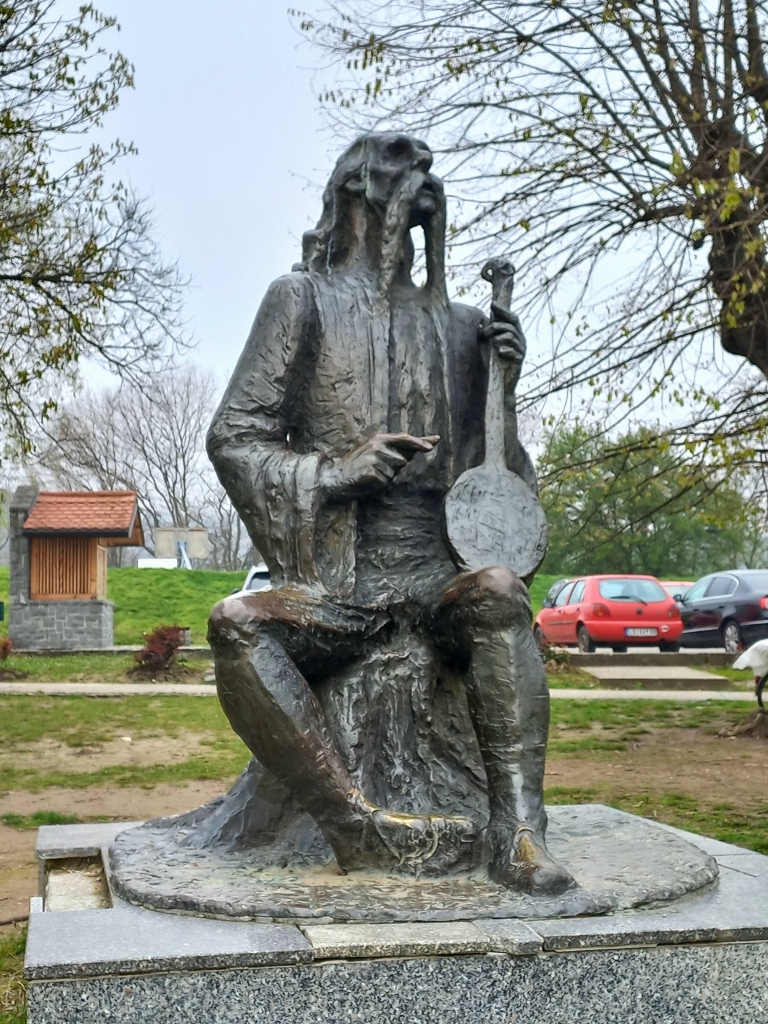 Monument to Filip Višnjić in Loznica
Monument to Filip Višnjić in Loznica
Here on the top of the hillock, in the direct proximity of the church, there is also primary school “Anta Bogićević.” The oldest school in Loznica area was founded in 1795 and it was situated right on the spot where the present-day school is. This school was also attended by Vuk Karadžić (more about him later). It was a private school and from time to time, depending on the circumstances, it would stop working. A new school was built in the same place in 1840, but when Austria-Hungary tried to penetrate onto the territory of Serbia in the summer and autumn of 1914, this school was destroyed in the bombardment of Loznica. The building that can be seen here today was built in 1928.
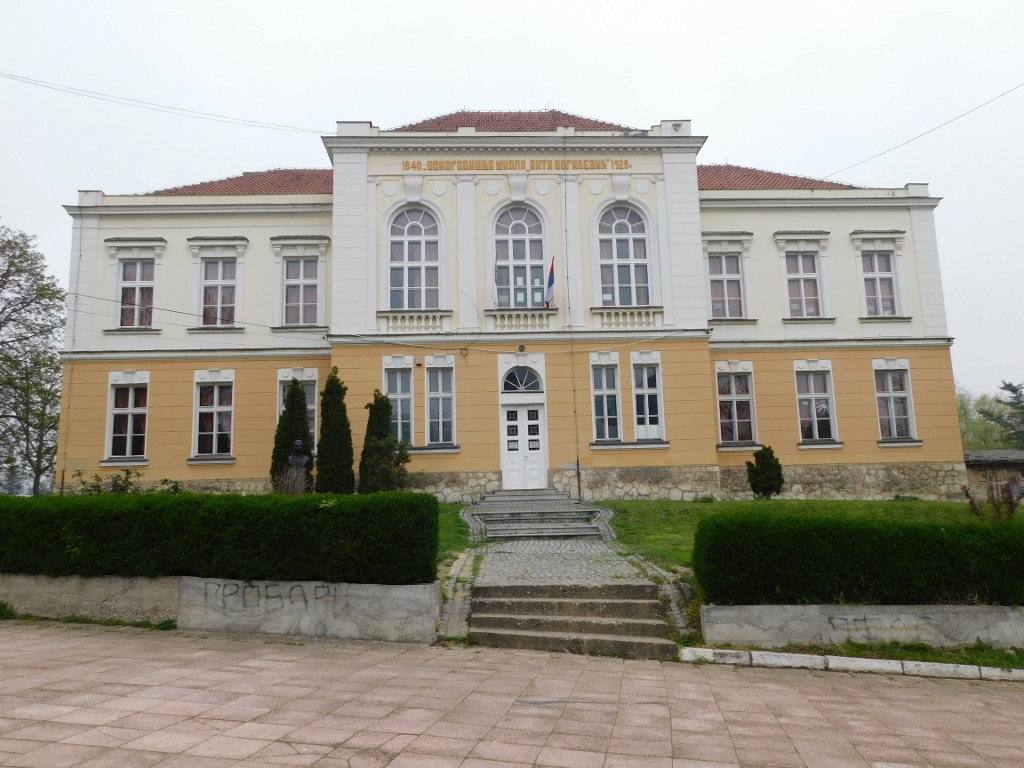 Primary school “Anta Bogićević”
Primary school “Anta Bogićević”
Within the scope of my travelogues about Serbia, I have already mentioned that after the gradual liberation from the Ottomans in the 19th century, it was very important to work on the education of the nation, especially the young generations. I remember that many years ago I read some excerpts written by foreigners who travelled around Serbia at the beginning of the 19th century, and even later, and my impression at the time was that these territories seemed like the land of Conan the Barbarian. No wonder, since during the centuries under the Ottomans the literacy among Serbs was mostly maintained in monasteries and it is also widely known that Prince Miloš Obrenović was illiterate (although he was an exceptionally capable ruler and a wise and cunning negotiator). So, as the country was gaining its freedom, it was important to work on the literacy and education of the nation. For this reason, the building of primary schools was exceptionally important and accentuated.
After this short walk around the top of the elevation where Loznički grad is, I went down for a few hundred metres right to the centre of the town and there I walked around the square-shaped Trg Jovana Cvijića (Jovan Cvijić Square) with Školski park (School Park) there. In the middle of the square or the park, there is a monument to Jovan Cvijić who was born right here in Loznica.
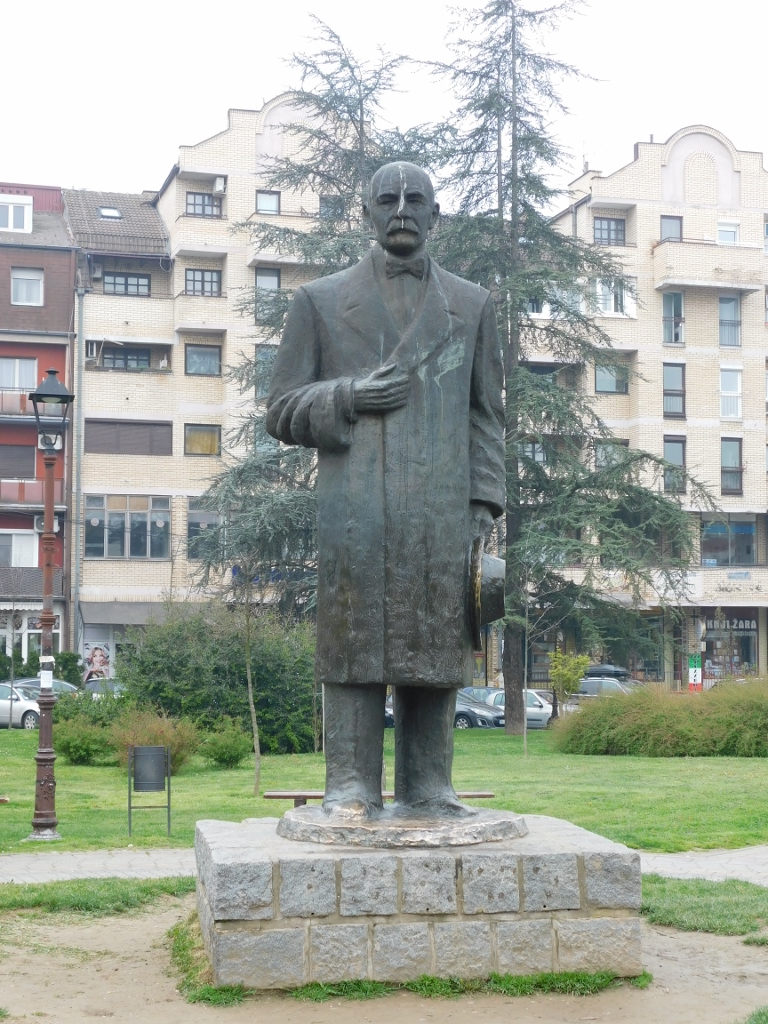 Monument to Jovan Cvijić
Monument to Jovan Cvijić
Jovan Cvijić (1865-1927) was a scientist, a founder of geography in Serbia and a founder of the Serbian Geographical Society. He dedicated his professional life to the study of the entire Balkan Peninsula, including its relief, settlements, origin of the population and their ethnic and social characteristics. He was the President of the Serbian Royal Academy (nowadays the Serbian Academy of Sciences and Arts, as well as the Rector of the University of Belgrade.
At one of the corners of this square there is the building of Grammar School “Vuk Karadžić” that was built in 1892 and that nowadays represents a monument of culture. Its importance is reflected both in the importance of education and its development, and in its architectural features. It was originally a single-storey building, but around the middle of the 20th century the upper floor was added.
 Grammar School “Vuk Karadžić” in Loznica
Grammar School “Vuk Karadžić” in Loznica
In 1971, a mosaic was added above the entrance and it exhibits a famous couplet by Serbian poet Branko Miljković (1934-1961) – Will freedom know how to sing songs the same way the enslaved sang about it. The mosaic is dedicated to the students and professors of the grammar school who were killed during WWI and WWII.
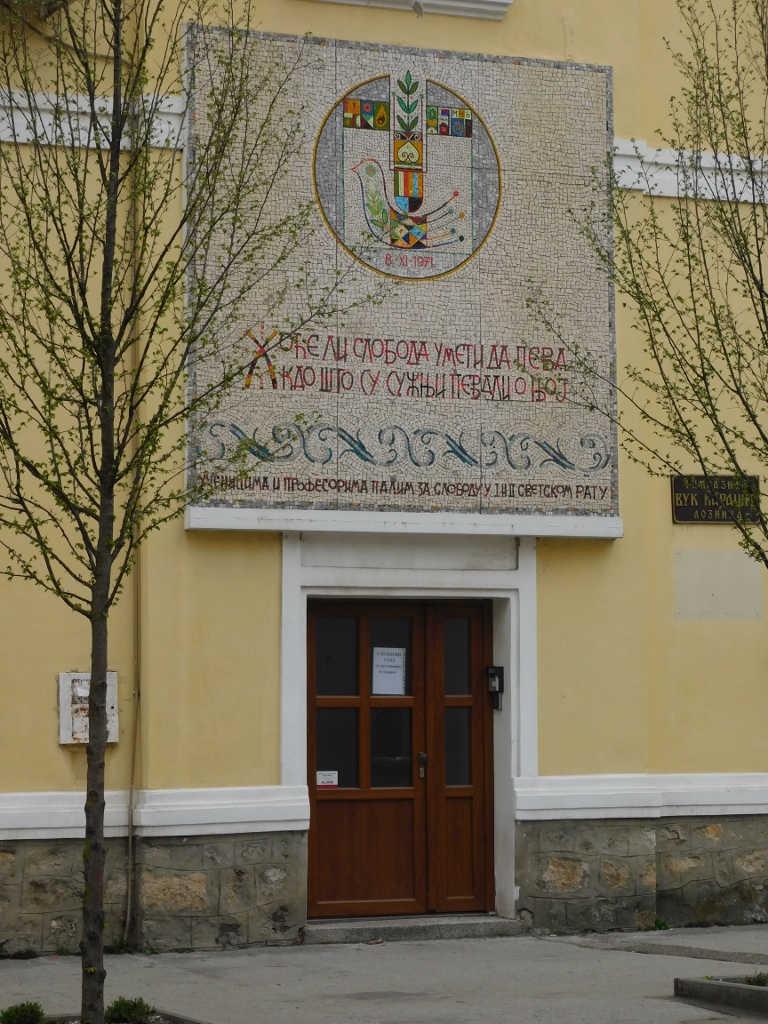 Grammar School “Vuk Karadžić in Loznica, a detail
Grammar School “Vuk Karadžić in Loznica, a detail
At the neighbouring corner of Trg Jovana Cvijića, there is yet another monument of culture and that is the building of “Stara apoteka” (Old Pharmacy) that was built under the influence of the European architecture at the beginning of the 20th century. The building is important as it constitutes a unique example of the urban architecture from this period in this part of Serbia. Originally, the building had a business and residential purpose, but today it houses the Jadar Museum. By the way, Jadar is the name of a river flowing not far from Loznica, as well as of the entire region that encompasses the valley of the Jadar river.
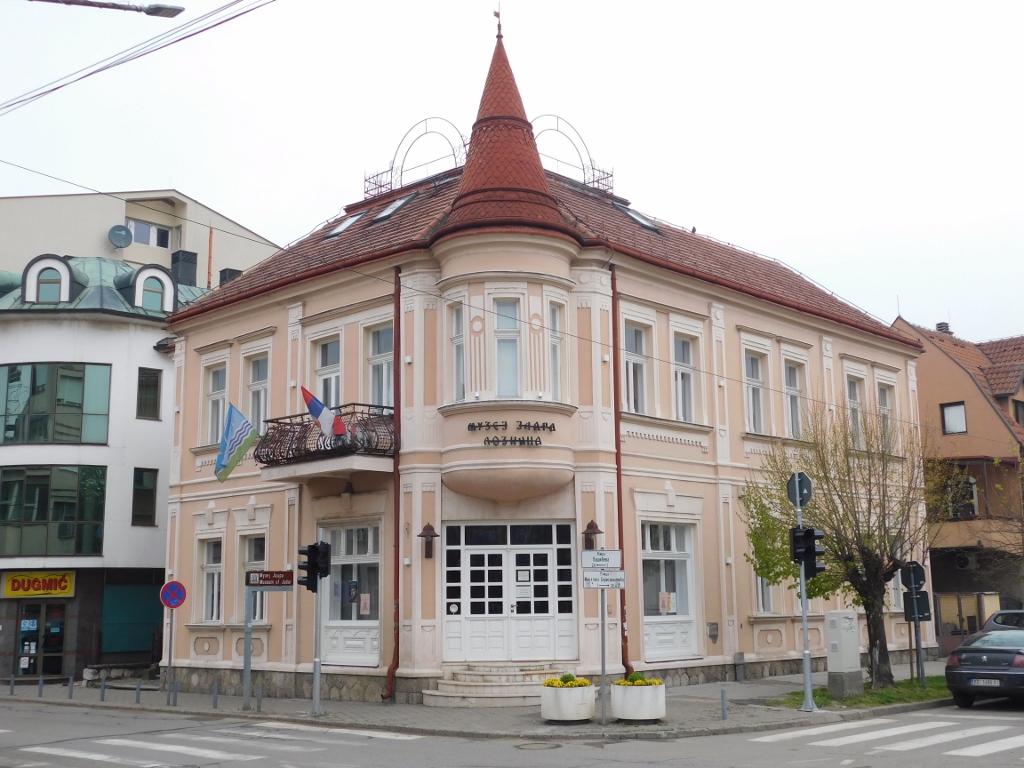 “Stara apoteka” building, today – the Jadar Museum
“Stara apoteka” building, today – the Jadar Museum
As I’ve already mentioned, I could not visit the museum on Sunday when I walked around Loznica, but I came here again a couple of days later and then I had a wonderful experience. Namely, I was the only visitor at the time and so the young man who worked here on this day locked up the museum and we did the tour around it together. That was by far the best guided museum tour in my life and that brilliant young man’s name is Stefan Pavlović. My impression was that few visitors come to the museum and he had a desire to share his obviously huge knowledge with somebody. The museum is small, I stayed there for an hour and a half, and I’m sure that Mr. Pavlović could go on for who knows how long. Regardless of the fact that the closing time was getting nearer, he kept on talking with undiminished enthusiasm about various exhibits, events and customs, and it was in fact me who cut the visit “short,” for I had to return to Banja Koviljača, plus I truly felt sorry to keep Stefan there any longer. The visit to the museum is highly recommended!
The museum’s display starts with artefacts from prehistory, but I found it interesting that there was an addition of a geological piece that dates back to who knows when, but that was extracted recently.
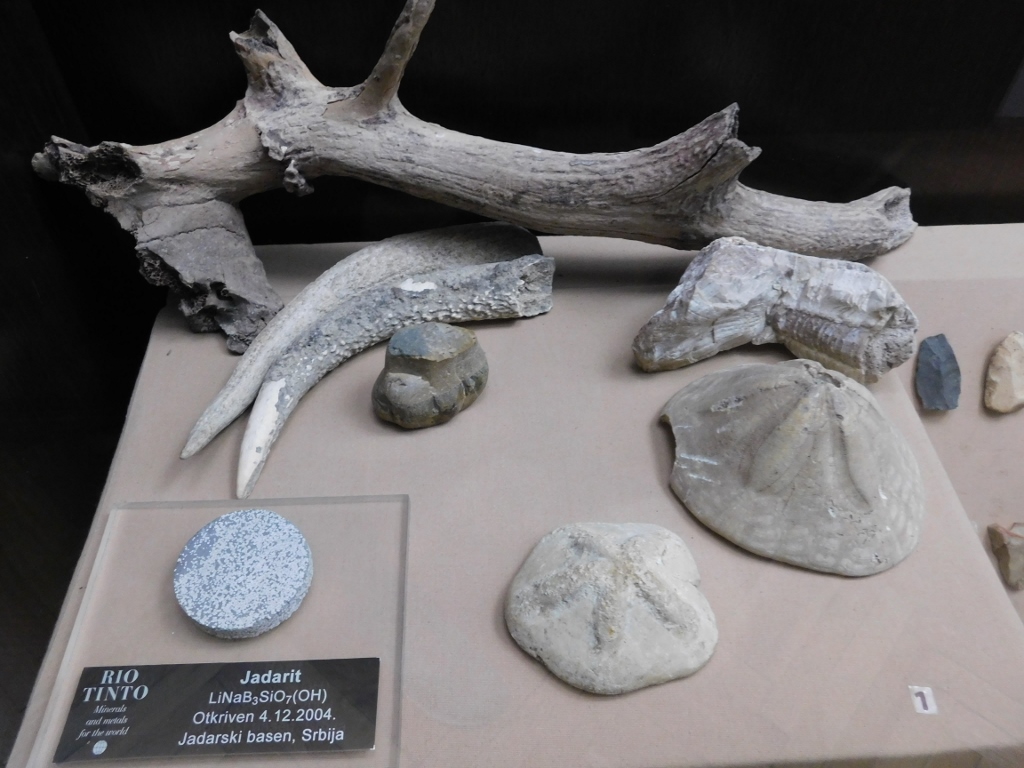 The Jadar Museum, a detail
The Jadar Museum, a detail
Namely, in the photo above, down and to the left, you can see a specimen of jadarite mineral in the shape of a circle. This mineral was discovered in 2004 precisely in the valley of the Jadar and for the time being this is the only site in the world where this mineral has been proved to exist. That is why it was named after the river. In addition to its technological aspects, what is interesting about this mineral is that its chemical formula (sodium lithium boron silicate hydroxide) differs from the fictitious kryptonite mentioned in the stories about Superman only in the detail that kryptonite also includes fluorine (sodium lithium boron silicate hydroxide with fluorine). At the time this drew a lot of media attention to something that usually stays below the radar, such as the discovery of a mineral.
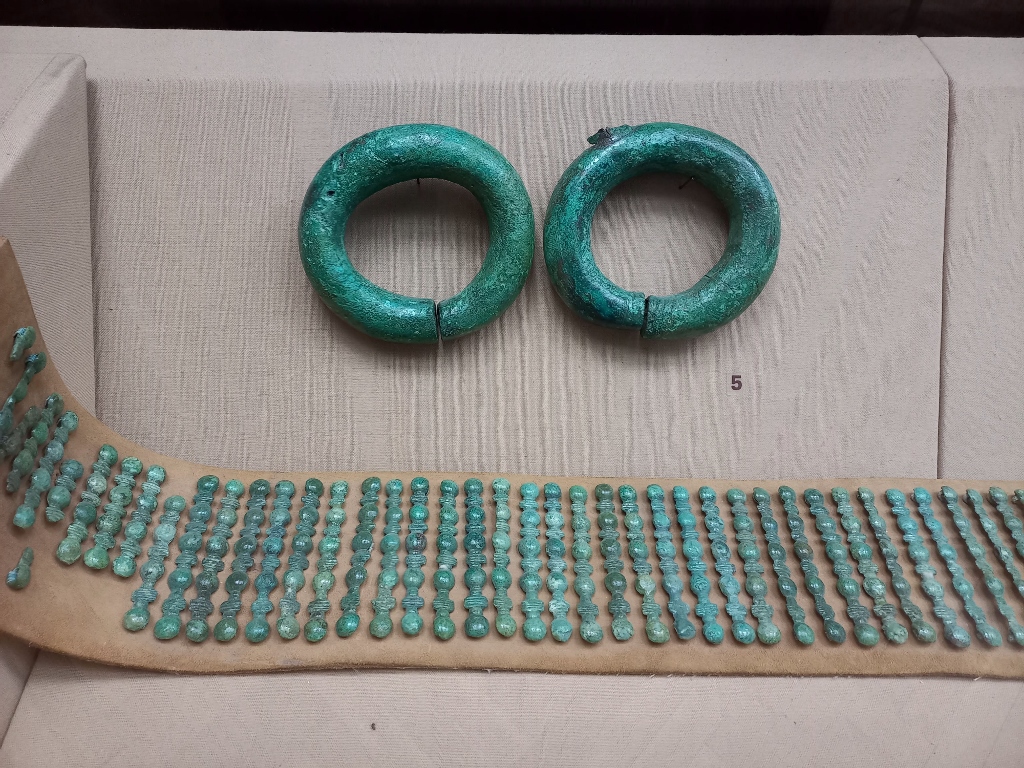 The Jadar Museum, bronze jewellery from prehistoric necropolises
The Jadar Museum, bronze jewellery from prehistoric necropolises
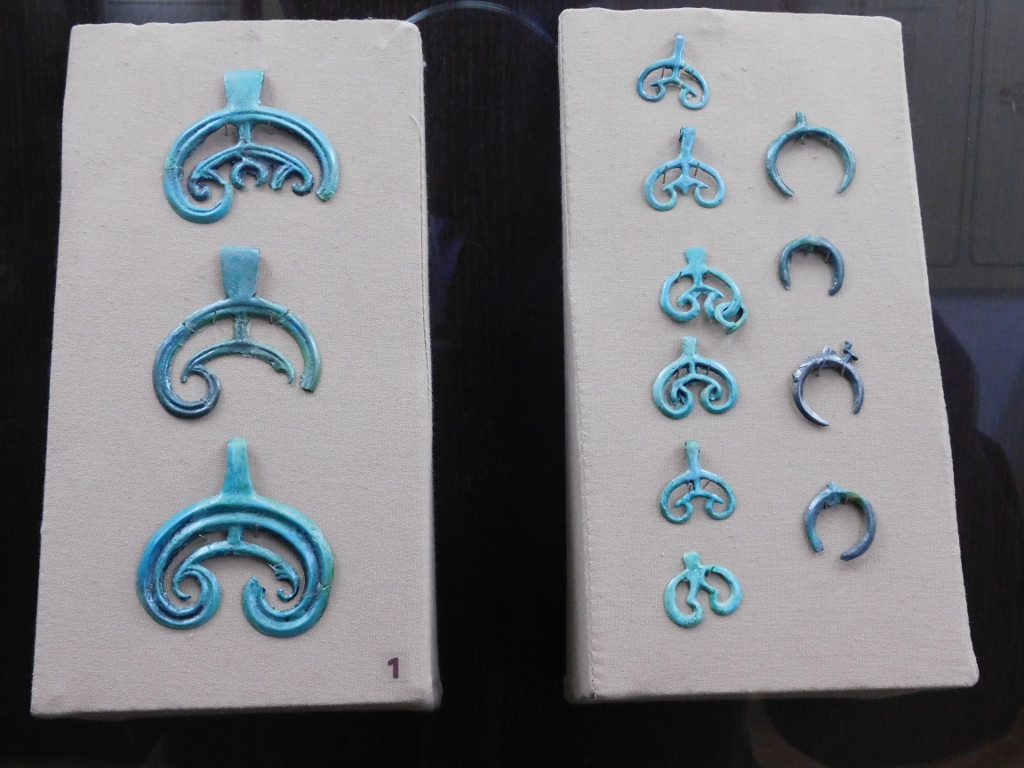 The Jadar Museum, bronze jewellery from prehistoric necropolises
The Jadar Museum, bronze jewellery from prehistoric necropolises
Needless to say, a good part of the museum is dedicated to the events of the 19th century and the first half of the 20th century, when Serbia fought for its liberation from the Ottomans and for gaining its statehood, as well those of WWI and WWII which left huge and horrible scars in this whole region, which I have already written about and on which I will have to say more later on.
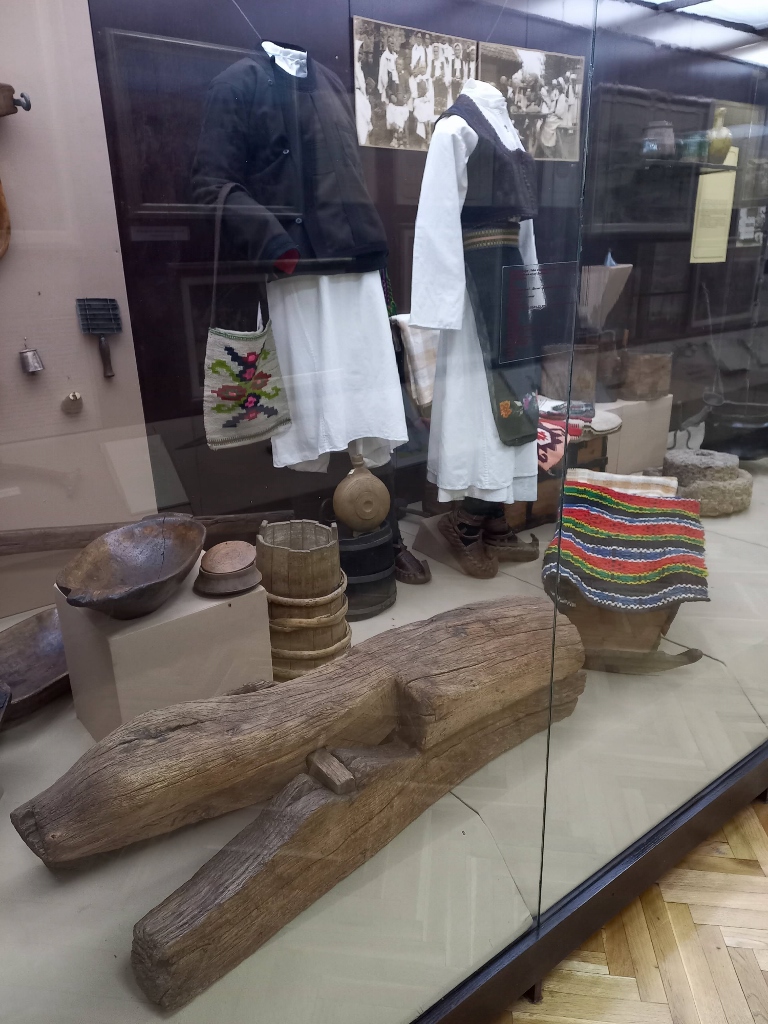 The Jadar Museum, ethnographic part of the museum
The Jadar Museum, ethnographic part of the museum
I found the ethnographic section interesting as well, particularly - lilanje or the custom linked to the firing of lilas (this is a fine example of Obscurum per obscurius (the obscure by the still more obscure)). Let me explain – a lila is a ritual object made of wild cherry tree cortex that is peeled off a tree (while the tree can regenerate) and then fixed to a long wooden staff made of hazel tree. This is dried for a couple of days and then on the day of the Feast of St. Peter and Paul (12 July), as well as on some other important dates, the lilas are lit and the children carry them around pens while running and singing. The purpose is to protect animals and crops and to make them even more abundant. Although the custom is used on the days of Christian holidays, it is obvious that this is a pagan custom and it is characteristic only of this region and the basin of the Drina river. In 2017, the lilanje was included in the List of Intangible Cultural Heritage of Serbia.
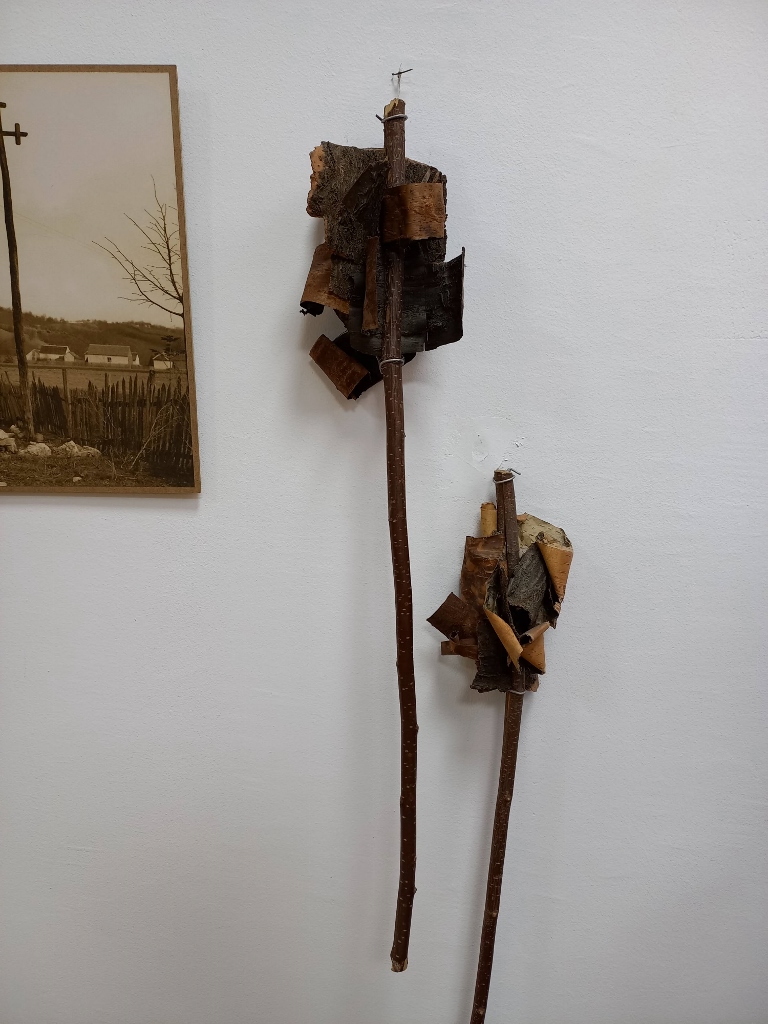 The Jadar Museum, lilas on a museum wall
The Jadar Museum, lilas on a museum wall
On Sunday when I walked around Loznica, after the visit to Trg Jovana Cvijića square, having passed by the building of the Grammar School, I walked to a bridge over the small Štira river. Although it is not my intention to advertise a restaurant/café that exists a little farther also above the river, I must say that every time I came to Loznica I enjoyed the view from the bridge used as a street.
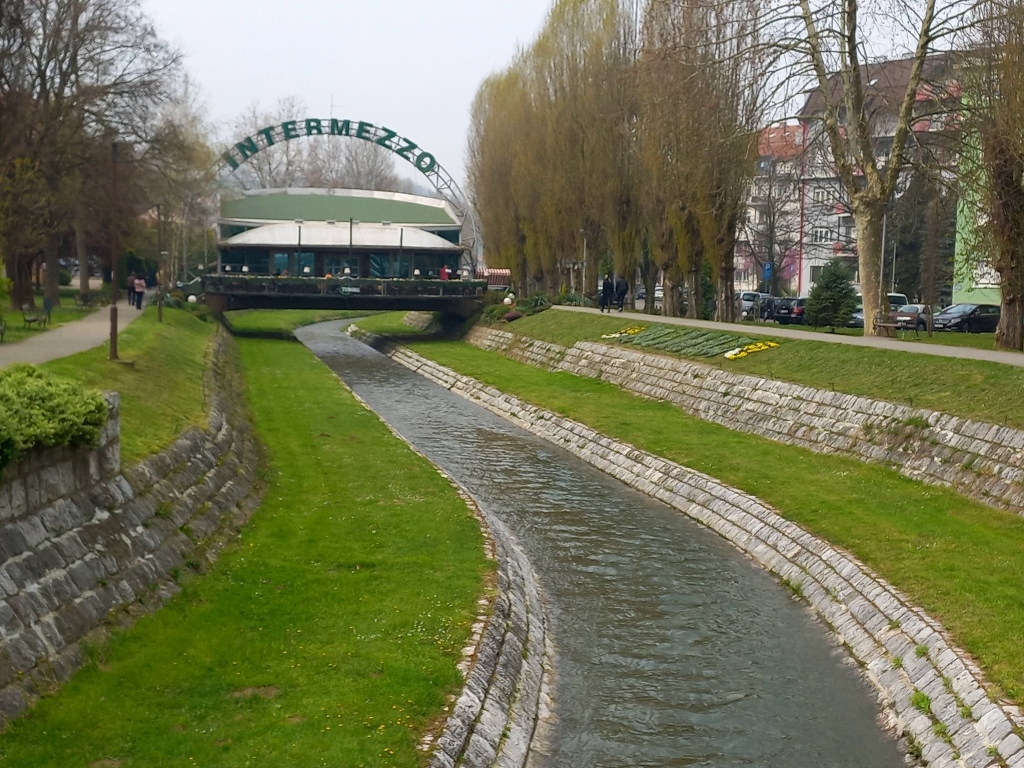 The Štira river in Loznica
The Štira river in Loznica
There is a small park nearby with a monument to Vuk Stefanović Karadžić. I will write more about Vuk Karadžić (1787-1864) in my next sequel of the travel stories covering this part of west Serbia, but let me just mention that he was born in village Tršić that is some 6 km southeast of Loznica. Vuk Karadžić was by far the most influential reformer of the Serbian language and script, but he was also an important anthropologist and philologist, which means that he is very significant for entire Serbia, as well as Loznica and this region that are rightfully proud of him.
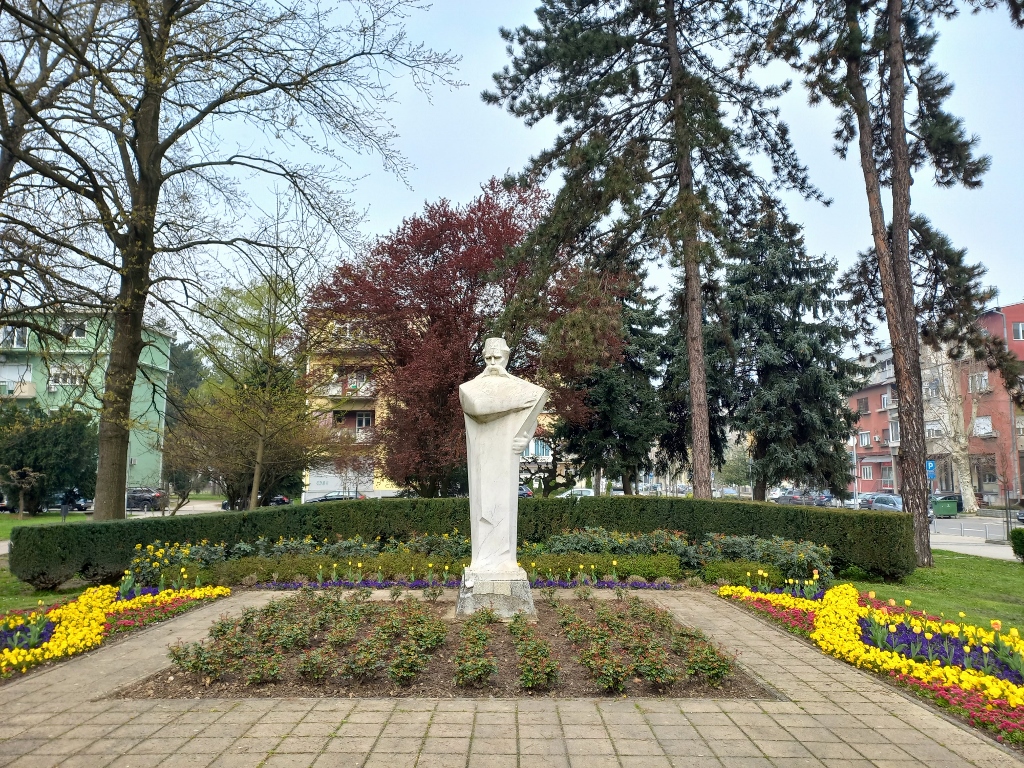 Monument to Vuk Karadžić in Loznica
Monument to Vuk Karadžić in Loznica
From the bridge and the Štira river, in the opposite direction from the monument to Vuk Karadžić, starts a pedestrian street in which the House of Culture “Vuk Karadžić” is located. This building is a monument of culture and it was built in 1936. The main facade of the building is adorned by a comparatively simple, but certainly very pretty decoration.
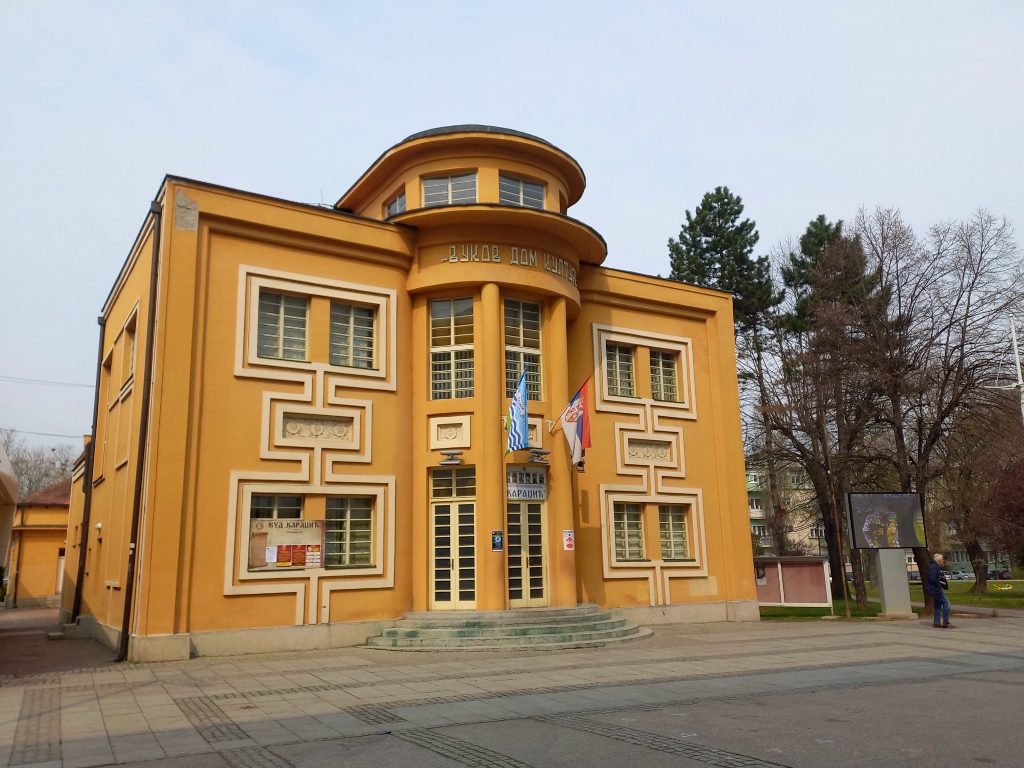 House of Culture “Vuk Karadžić”
House of Culture “Vuk Karadžić”
From here I walked a little more around the centre of Loznica and then I got into my car and drove to the hospital complex where there is a monument of culture – the Old Hospital building. I parked the car nearby and then walked to the entrance into the complex where I came across a security guard. It was Sunday, end of the morning and the hospital visits had not started yet, so the guard was a little puzzled seeing me with a photo-camera around my neck. I told him I was a “tourist” and that I was interested in the Old Hospital building, but I did not know where it was. He hesitated a little saying “he only recently started working there,” but after we talked a little he realised that I may be a “tourist” and a strange eccentric, but I was at the same time a visibly serious woman. By the way, later I realised that the Old Hospital building is easily accessible and quite nicely visible from another street, i.e., it is not necessary to enter the hospital complex. Still, after my visit I did go back to the security guard and thanked him for his kindness.
The hospital building I was looking for is situated in Dr. Marina street and nowadays it houses the Psychiatry and Neurology Departments. The building was constructed in 1912 and at the time of my visit (April 2023) some works on the building rehabilitation were being carried out. The facade was already well restored and I could see that, for instance, protective bird spikes had been installed above the windows in order to make sure that the new facade would remain in a good state for a longer period of time.
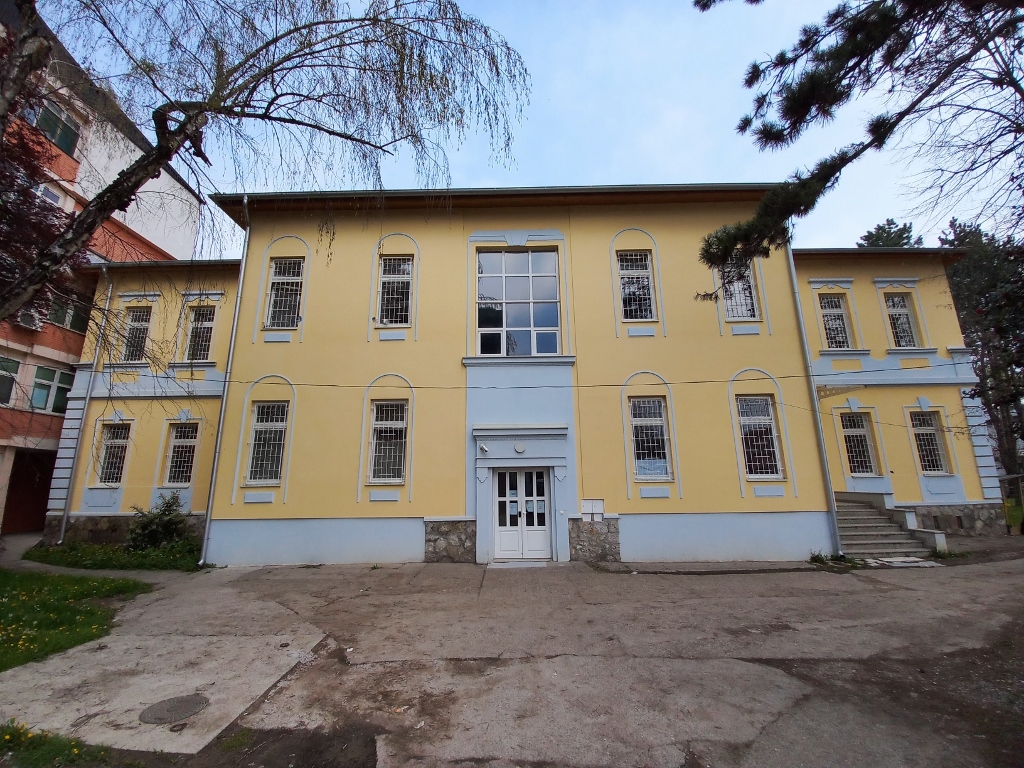 Old Hospital building in Loznica
Old Hospital building in Loznica
Parallel to the importance of the development of education, it was also important to improve the health care of the population in the new state. Naturally, this applied to Loznica and all of Jadar region as well. Earlier, the hospital was located in a house that was used since 1882 and that could receive 10 patients at the most. The new hospital had the capacity sufficiently increased to provide services to a larger number of patients in line with the needs at the time.
By the way, Dr. Marina street was named like that after doctor Milenko Marin. After the establishment of the new country following WWI, in 1922, the Ministry of Health sent here young dr. Milenko Marin, born in the region of Syrmia, to a position of a district physician. Already after two years he was appointed to the position of the administrator of the hospital in Loznica where he remained until 1953. Since he was very dedicated and noble doctor and man, he was extremely respected and loved by the people. Dr. Marin got his education at the universities in Graz, Vienna and Prague (all in Austria-Hungary at the time), but he also had very broad education and diverse interests.
Here, at the hospital, I finished with my sightseeing of the centre of Loznica and the interesting monuments that could be seen here, but before returning to Banja Koviljača I stopped at yet another interesting site that is not in the centre of the town.
This is a restaurant on the very bank of the Drina river. I had had lunch here several years earlier in the period when the weather was warmer and there was more greenery, but even now it was not too bad.
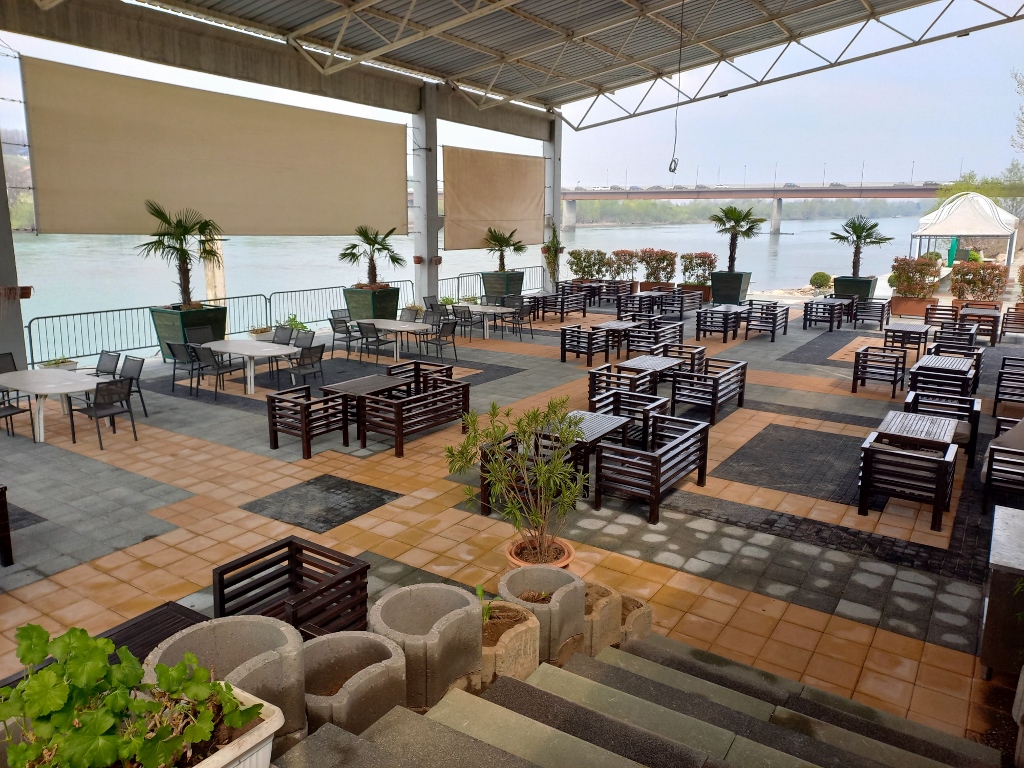 Restaurant on the bank of the Drina
Restaurant on the bank of the Drina
What is interesting is the position – on the very bank of the Drina river, while on the other bank there is already another country, Bosnia and Herzegovina. From the terrace one can see nicely a bridge that connects the two countries and at the ends of which are the respective border controls.
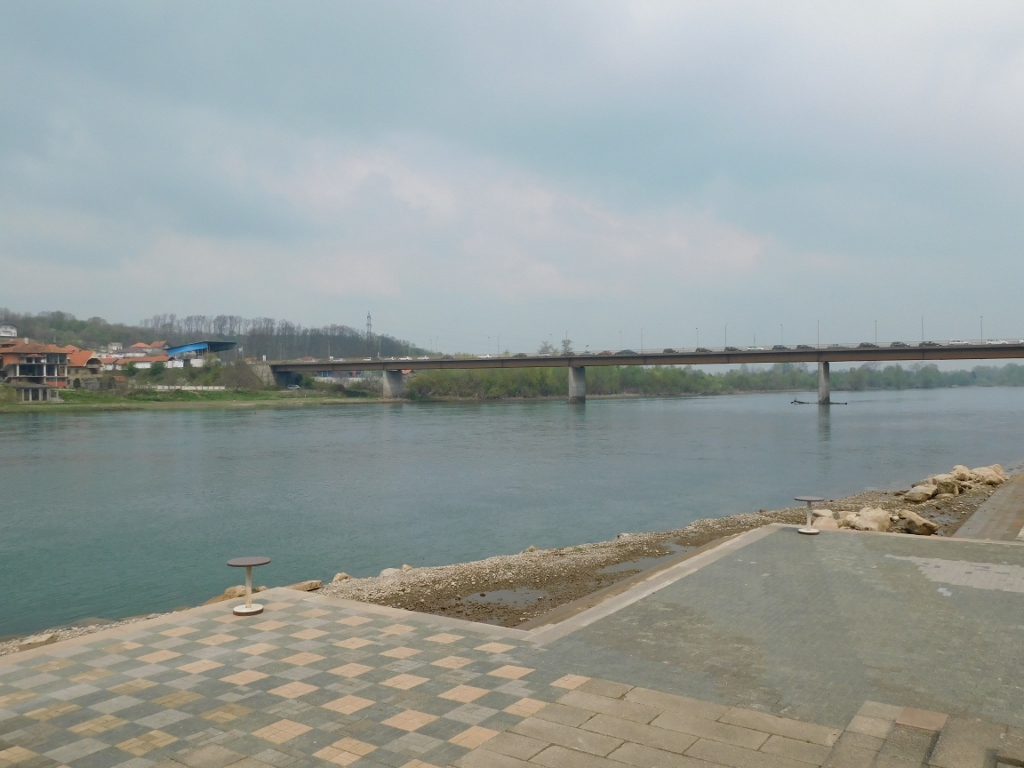 Bridge over the Drina that leads to Bosnia and Herzegovina
Bridge over the Drina that leads to Bosnia and Herzegovina
After a short break at the restaurant I walked to the bank itself which was very nice now, quiet and clean. So, on the other side, there is another country – Bosnia and Herzegovina.
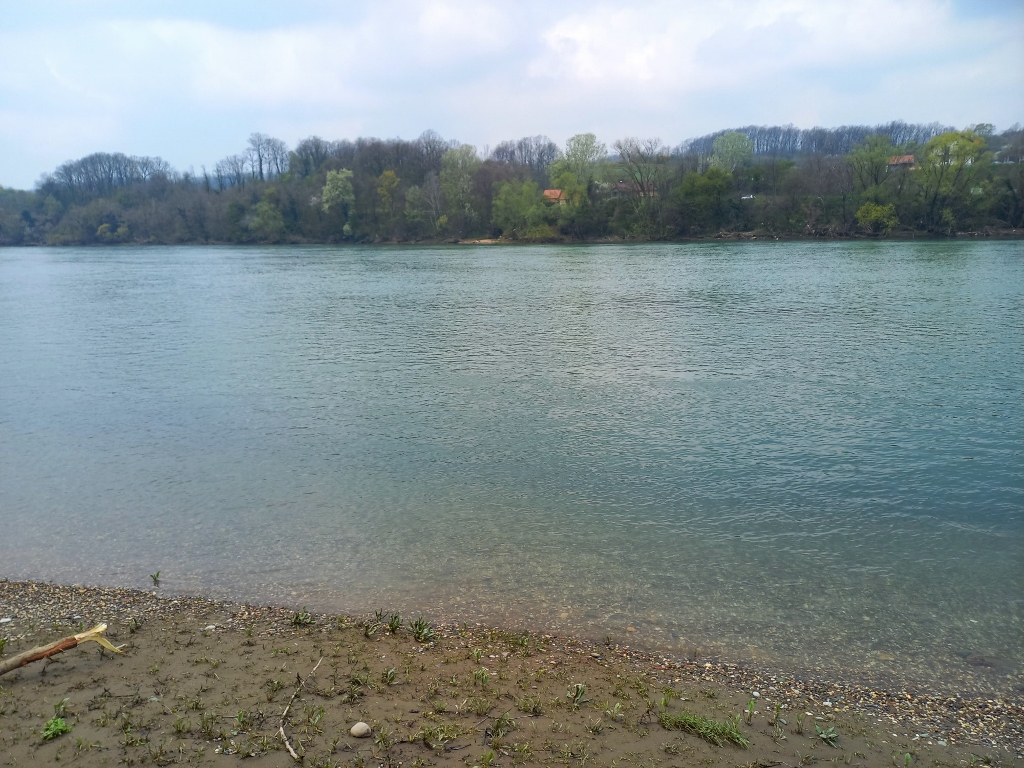 The Drina river
The Drina river
Then I returned to the parking lot and the car, but there was also a football pitch there with a match in its full swing, so I briefly stopped by to have a look. There were no problems about this, for there was no need to buy any tickets. This was in fact the first football game I was present at. Somehow, I’ve always wanted to believe that my first football match would be a Buenos Aires derby between Boca Juniors and River Plate. The fate brought me here to the match between Mladost from Loznica and 14. oktobar from Draginac. The certain sign that this was the fate lies in the fact that I suddenly felt like filming a short video and as it turned out it was right at the moment when a penalty kick was played. You can see the result in the following clip:
Since the Drina flows in the direct proximity of Banja Koviljača, I walked to its banks on a couple of occasions. Once, after the breakfast, I walked to the river bank which in one place is less than one kilometre away from the very centre of Banja Koviljača. And once I walked to ethno-village “Sunčana reka” that is some 5 km away from the spa town. I would not recommend this, though, since there isn’t any proper walking path – I actually walked by the road. On the other hand, that part was also rather boring, so I returned by taxi.
The only thing I found interesting while walking, taking good note of the vehicles passing by, was a wild plant – field horsetail (Equisetum arvense) that I noticed in several places.
 Field horsetail
Field horsetail
As for the ethno-village, this is rather a restaurant/hospitality place that also incorporates the bank of the Drina, but I cannot say much about it since I only walked a little around and took a coffee. The landscape is pretty, but, after all, this entire area is such.
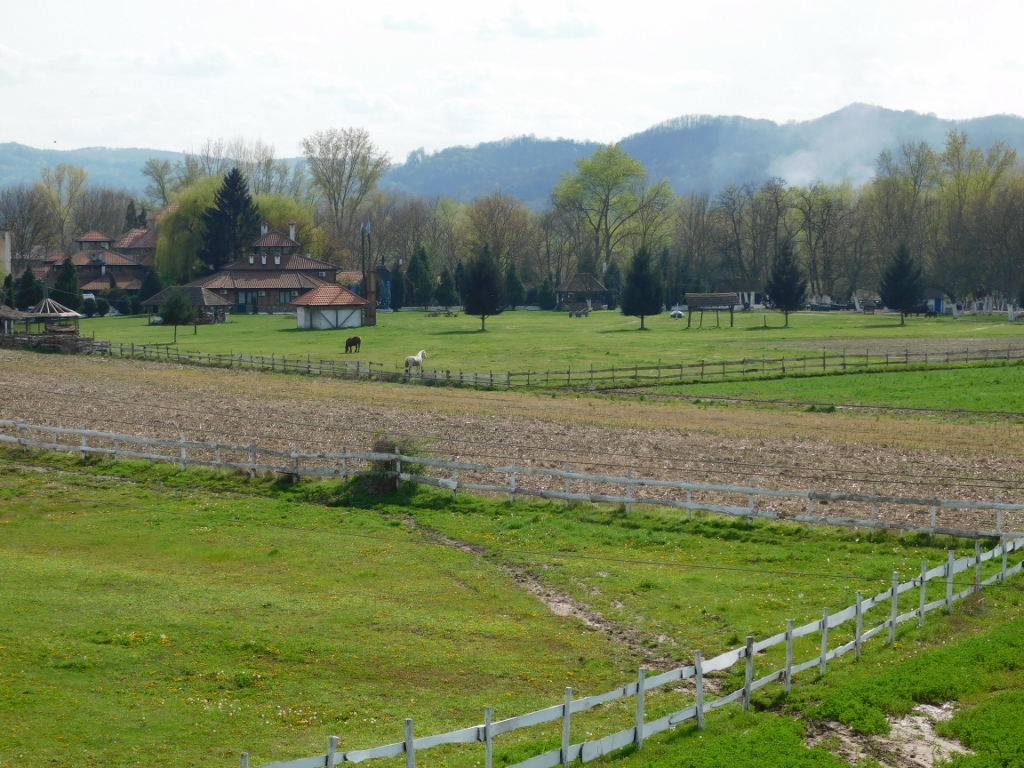 Getting close to the ethno-village
Getting close to the ethno-village
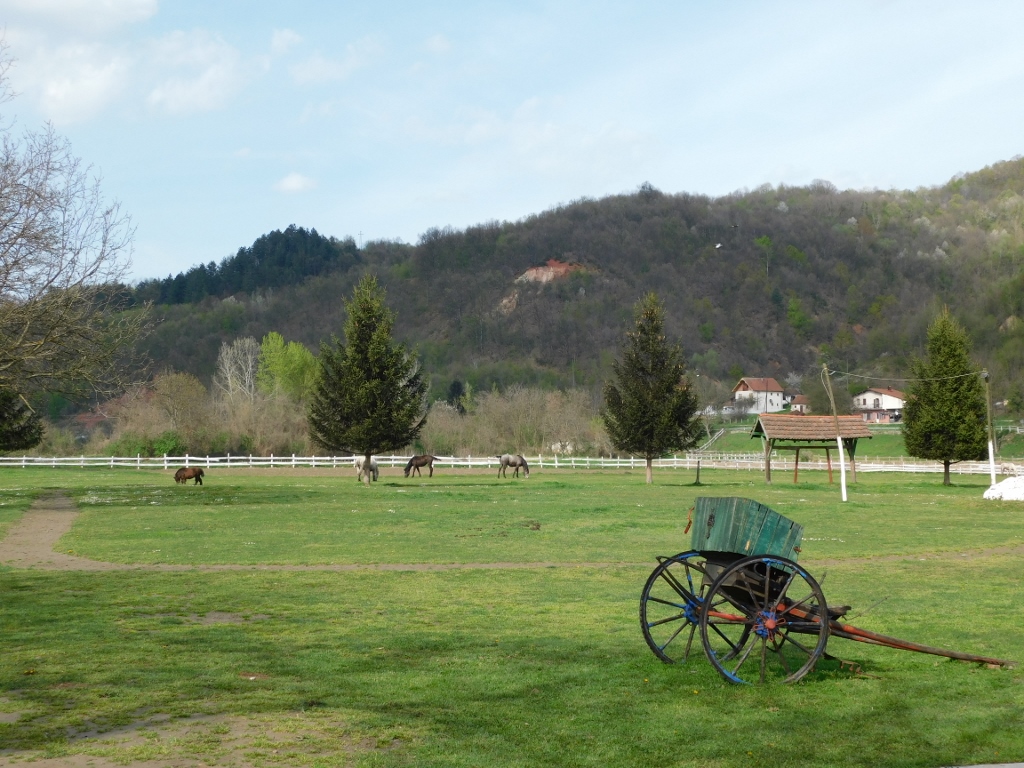 Ethno-village “Sunčana reka,” a detail
Ethno-village “Sunčana reka,” a detail
But, what I did find interesting was when I noticed a wooden board at the ethno-village that said “Settlement Robert De Niro” and that can be seen in the photo below.
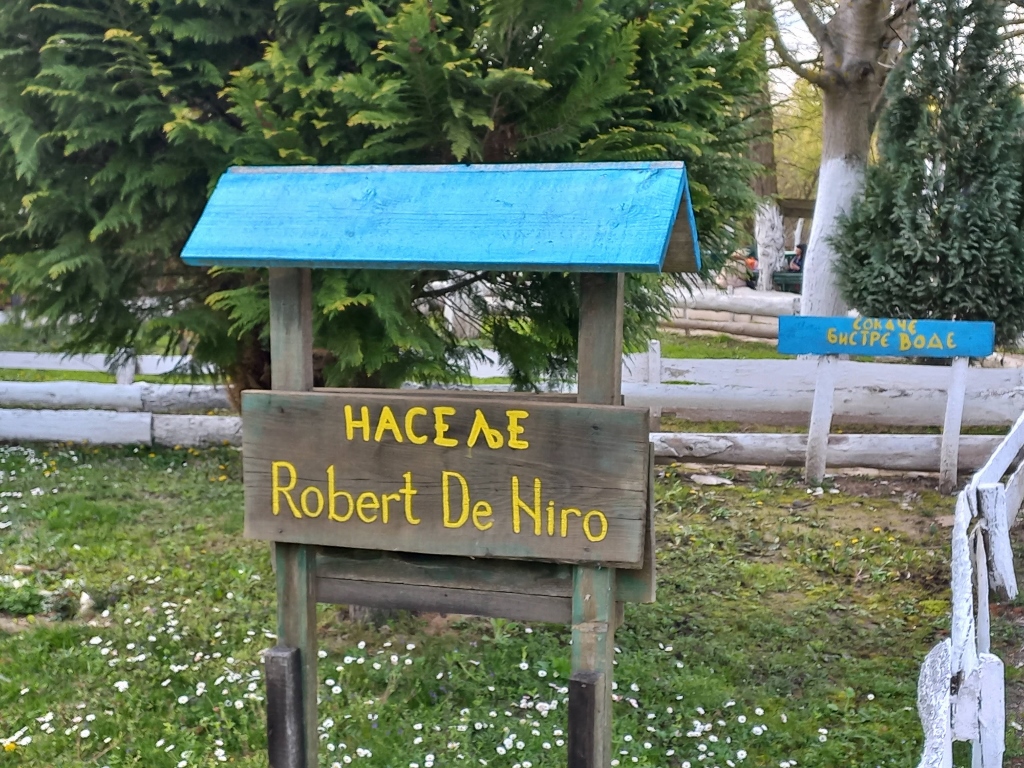 Ethno-village “Sunčana reka,” a detail
Ethno-village “Sunčana reka,” a detail
I presume that the reason for displaying this board is the story that is often retold around here. Namely, people like to say that a daughter of Robert de Niro, Drena (pronounced in the same way as the name of the river in Serbian), got its name after the Drina river, thus suggesting a “great love” of the famous actor for Serbia (people in Bosnia have the same delusions). It needs to be said that de Niro adopted this girl, a daughter of his wife, when the child was already 5. I think that this busts the myth about the connection between de Niro and the Balkans. However, this does not prevent people from expressing local pride at this ethno-village on the banks of the beautiful Drina river that mostly flows between Serbia and Bosnia and Herzegovina.
 The Drina river by the ethno-village “Sunčana reka”
The Drina river by the ethno-village “Sunčana reka”